使用 ThreadLocal 一次解决老大难问题
每个线程需要一个独享对象(通常是 工具类 ,典型需要使用的类有SimpleDateFormat和Random)
每个Thread内有 自己 的实例副本, 不共享
比喻: 教材 只有一本,一起做笔记有线程安全问题。 复印 后没有问题,使用ThradLocal相当于复印了教材。
1.2 场景2
每个线程内需要保存全局变量(例如在拦截器中获取用户信息),可以让不同方法直接使用, 避免参数传递 的麻烦
2.对以上场景的实践
2.1 实践场景1
/**
* 两个线程打印日期
*/
public class ThreadLocalNormalUsage00 {
public static void main(String[] args) throws InterruptedException {
new Thread(new Runnable() {
@Override
public void run() {
String date = new ThreadLocalNormalUsage00().date(10);
System.out.println(date);
}
}).start();
new Thread(new Runnable() {
@Override
public void run() {
String date = new ThreadLocalNormalUsage00().date(104707);
System.out.println(date);
}
}).start();
}
public String date(int seconds) {
//参数的单位是毫秒,从1970.1.1 00:00:00 GMT 开始计时
Date date = new Date(1000 * seconds);
SimpleDateFormat dateFormat = new SimpleDateFormat("yyyy-MM-dd hh:mm:ss");
return dateFormat.format(date);
}
}
复制代码
运行结果

因为中国位于东八区,所以时间从1970年1月1日的8点开始计算的
/**
* 三十个线程打印日期
*/
public class ThreadLocalNormalUsage01 {
public static void main(String[] args) throws InterruptedException {
for (int i = 0; i < 30; i++) {
int finalI = i;
new Thread(new Runnable() {
@Override
public void run() {
String date = new ThreadLocalNormalUsage01().date(finalI);
System.out.println(date);
}
}).start();
//线程启动后,休眠100ms
Thread.sleep(100);
}
}
public String date(int seconds) {
//参数的单位是毫秒,从1970.1.1 00:00:00 GMT 开始计时
Date date = new Date(1000 * seconds);
SimpleDateFormat dateFormat = new SimpleDateFormat("yyyy-MM-dd hh:mm:ss");
return dateFormat.format(date);
}
}
复制代码
运行结果
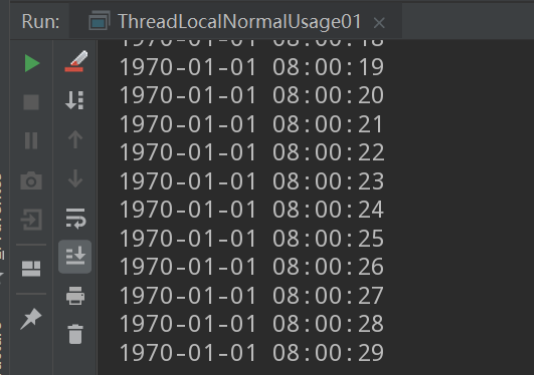
多个线程打印自己的时间(如果线程超级多就会产生性能问题),所以要使用线程池。
/**
* 1000个线程打印日期,用线程池来执行
*/
public class ThreadLocalNormalUsage02 {
public static ExecutorService threadPool = Executors.newFixedThreadPool(10);
public static void main(String[] args) throws InterruptedException {
for (int i = 0; i < 1000; i++) {
int finalI = i;
//提交任务
threadPool.submit(new Runnable() {
@Override
public void run() {
String date = new ThreadLocalNormalUsage02().date(finalI);
System.out.println(date);
}
});
}
threadPool.shutdown();
}
public String date(int seconds) {
//参数的单位是毫秒,从1970.1.1 00:00:00 GMT 开始计时
Date date = new Date(1000 * seconds);
SimpleDateFormat dateFormat = new SimpleDateFormat("yyyy-MM-dd hh:mm:ss");
return dateFormat.format(date);
}
}
复制代码
运行结果
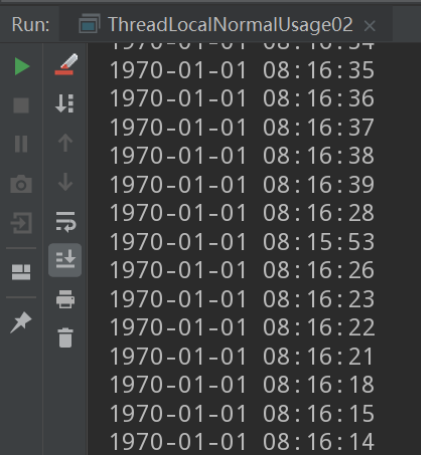
但是使用线程池时就会发现每个线程都有一个自己的 SimpleDateFormat 对象,没有必要,所以将 SimpleDateFormat 声明为静态,保证只有一个
/**
* 1000个线程打印日期,用线程池来执行,出现线程安全问题
*/
public class ThreadLocalNormalUsage03 {
public static ExecutorService threadPool = Executors.newFixedThreadPool(10);
//只创建一次 SimpleDateFormat 对象,避免不必要的资源消耗
static SimpleDateFormat dateFormat = new SimpleDateFormat("yyyy-MM-dd hh:mm:ss");
public static void main(String[] args) throws InterruptedException {
for (int i = 0; i < 1000; i++) {
int finalI = i;
//提交任务
threadPool.submit(new Runnable() {
@Override
public void run() {
String date = new ThreadLocalNormalUsage03().date(finalI);
System.out.println(date);
}
});
}
threadPool.shutdown();
}
public String date(int seconds) {
//参数的单位是毫秒,从1970.1.1 00:00:00 GMT 开始计时
Date date = new Date(1000 * seconds);
return dateFormat.format(date);
}
}
复制代码
运行结果
出现了秒数相同的打印结果,这显然是不正确的。
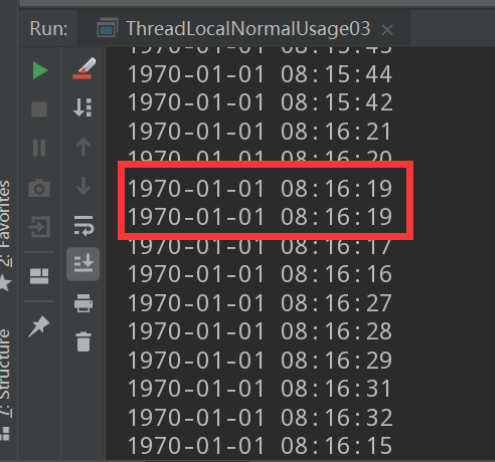
出现问题的原因
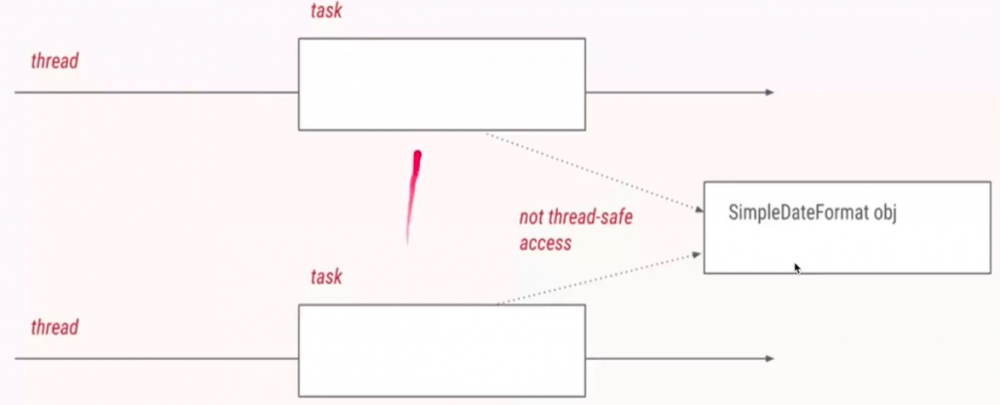
多个线程的task指向了同一个SimpleDateFormat对象,SimpleDateFormat是非线程安全的。
解决问题的方案
- 方案1:加锁
格式化代码是在最后一句 return dateFormat.format(date); ,所以可以为最后一句代码添加 synchronized 锁
public String date(int seconds) {
//参数的单位是毫秒,从1970.1.1 00:00:00 GMT 开始计时
Date date = new Date(1000 * seconds);
String s;
synchronized (ThreadLocalNormalUsage04.class) {
s = dateFormat.format(date);
}
return s;
}
复制代码
运行结果
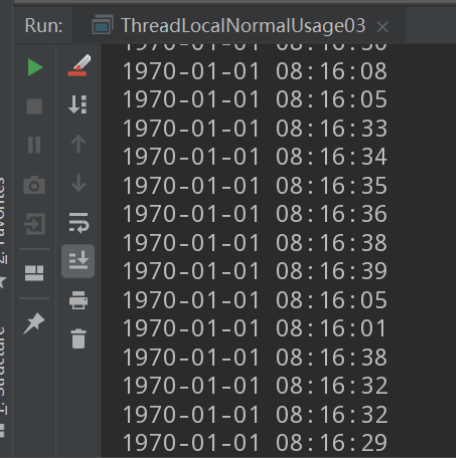
运行结果中没有发现相同的时间,达到了线程安全的目的
缺点:因为添加了 synchronized ,所以会保证同一时间只有一条线程可以执行,这在高并发场景下肯定不是一个好的选择,所以看看其他方案吧。
- 方案2:使用ThreadLocal
/**
* 利用 ThreadLocal 给每个线程分配自己的 dateFormat 对象
* 不但保证了线程安全,还高效的利用了内存
*/
public class ThreadLocalNormalUsage05 {
public static ExecutorService threadPool = Executors.newFixedThreadPool(10);
public static void main(String[] args) throws InterruptedException {
for (int i = 0; i < 1000; i++) {
int finalI = i;
//提交任务
threadPool.submit(new Runnable() {
@Override
public void run() {
String date = new ThreadLocalNormalUsage05().date(finalI);
System.out.println(date);
}
});
}
threadPool.shutdown();
}
public String date(int seconds) {
//参数的单位是毫秒,从1970.1.1 00:00:00 GMT 开始计时
Date date = new Date(1000 * seconds);
//获取 SimpleDateFormat 对象
SimpleDateFormat dateFormat = ThreadSafeFormatter.dateFormatThreadLocal.get();
return dateFormat.format(date);
}
}
class ThreadSafeFormatter {
public static ThreadLocal<SimpleDateFormat> dateFormatThreadLocal = new
ThreadLocal<SimpleDateFormat>(){
//创建一份 SimpleDateFormat 对象
@Override
protected SimpleDateFormat initialValue() {
return new SimpleDateFormat("yyyy-MM-dd hh:mm:ss");
}
};
}
复制代码
运行结果
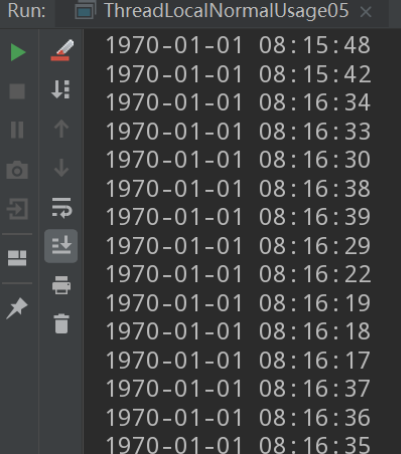
使用了ThreadLocal后不同的线程不会有共享的 SimpleDateFormat 对象,所以也就不会有线程安全问题
2.2 实践场景2
当前用户信息需要被线程内的所有方法共享
- 方案1:传递参数
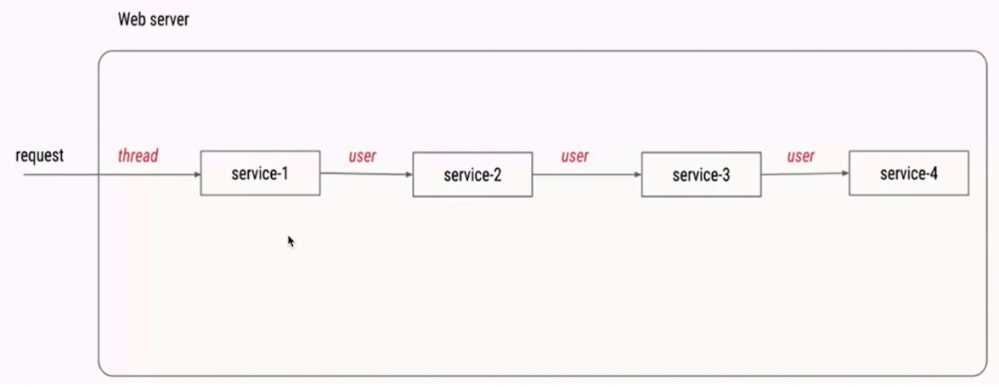
可以将user作为参数在每个方法中进行传递,
缺点:但是 这样做会产生代码冗余问题,并且可维护性差 。
- 方案2:使用Map
对此进行改进的方案是使用一个 Map ,在第一个方法中存储信息,后续需要使用直接 get() 即可,
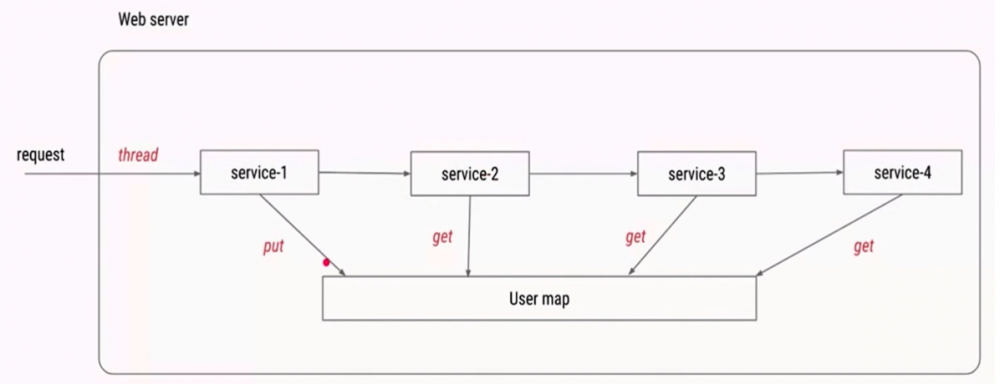
缺点:如果在单线程环境下可以保证安全,但是在 多线程环境下 是不可以的。如果使用加锁和 ConcurrentHashMap 都会产生 性能 问题。
- 方案3:使用ThreadLocal,实现 不同方法间 的资源共享
使用 ThreadLocal 可以避免加锁产生的性能问题,也可以避免层层传递参数来实现业务需求,就可以实现不同线程中存储不同信息的要求。
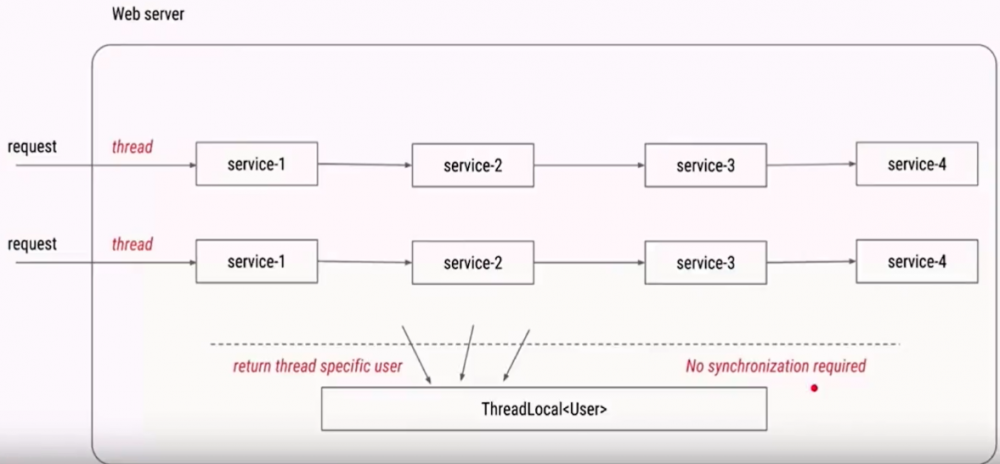
/**
* 演示 ThreadLocal 的用法2:避免参数传递的麻烦
*/
public class ThreadLocalNormalUsage06 {
public static void main(String[] args) {
new Service1().process();
}
}
class Service1 {
public void process() {
User user = new User("鲁毅");
//将User对象存储到 holder 中
UserContextHolder.holder.set(user);
new Service2().process();
}
}
class Service2 {
public void process() {
User user = UserContextHolder.holder.get();
System.out.println("Service2拿到用户名: " + user.name);
new Service3().process();
}
}
class Service3 {
public void process() {
User user = UserContextHolder.holder.get();
System.out.println("Service3拿到用户名: " + user.name);
}
}
class UserContextHolder {
public static ThreadLocal<User> holder = new ThreadLocal<>();
}
class User {
String name;
public User(String name) {
this.name = name;
}
}
复制代码
运行结果

3.对ThreadLocal的总结
- 让某个需要用到的对象实现 线程之间的隔离 (每个线程都有自己独立的对象)
- 可以在任何方法中 轻松的获取 到该对象
- 根据共享对象生成的时机选择使用
initialValue方法还是set方法initialValue set
4.使用ThreadLocal的好处
- 达到线程安全的目的
- 不需要加锁,执行效率高
- 更加节省内存,节省开销
- 免去传参的繁琐,降低代码耦合度
5.ThreadLocal原理
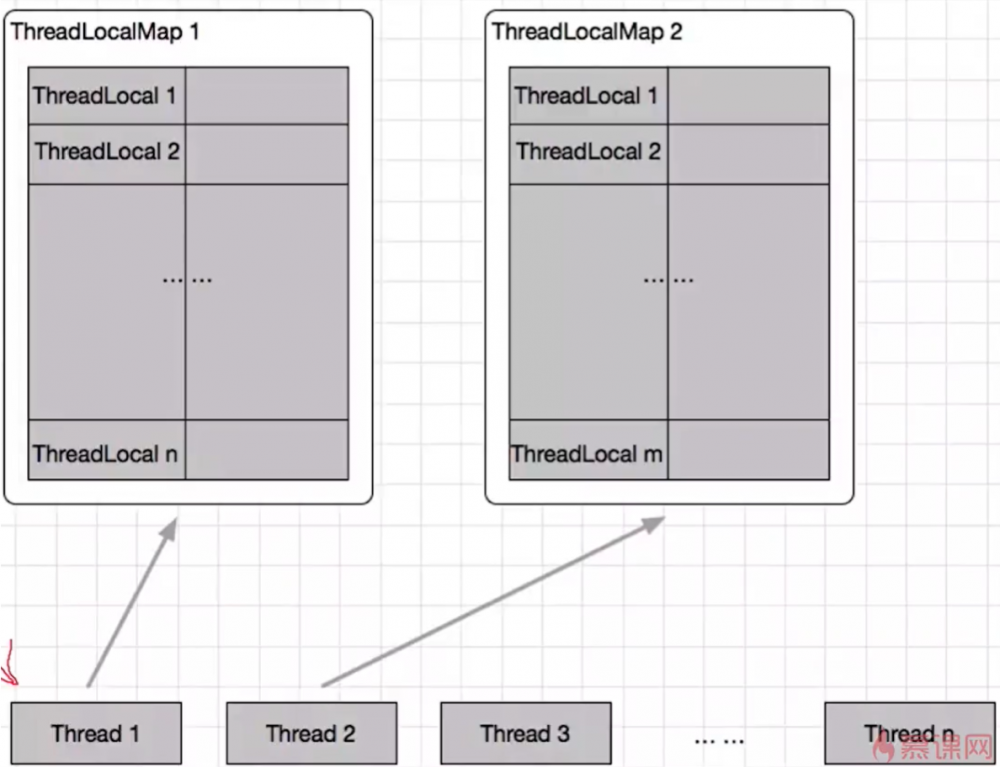
- Thread
- ThreadLocal
- ThreadLocalMap
在Thread类内部有有 ThreadLocal.ThreadLocalMap threadLocals = null; 这个变量,它用于存储 ThreadLocal ,因为在同一个线程当中可以有多个 ThreadLocal ,并且多次调用 get() 所以需要在内部维护一个 ThreadLocalMap 用来存储多个 ThreadLocal
5.1 ThreadLocal相关方法
-
T initialValue()
该方法用于设置初始值,并且在调用
get()方法时才会被触发,所以是 懒加载 。但是如果在
get()之前进行了set()操作,这样就不会调用initialValue()。通常每个线程只能调用 一次 本方法,但是调用了
remove()后就能再次调用public T get() { Thread t = Thread.currentThread(); ThreadLocalMap map = getMap(t); //获取到了值直接返回resule if (map != null) { ThreadLocalMap.Entry e = map.getEntry(this); if (e != null) { @SuppressWarnings("unchecked") T result = (T)e.value; return result; } } //没有获取到才会进行初始化 return setInitialValue(); } private T setInitialValue() { //获取initialValue生成的值,并在后续操作中进行set,最后将值返回 T value = initialValue(); Thread t = Thread.currentThread(); ThreadLocalMap map = getMap(t); if (map != null) map.set(this, value); else createMap(t, value); return value; } public void remove() { ThreadLocalMap m = getMap(Thread.currentThread()); if (m != null) m.remove(this); } 复制代码 -
void set(T t)
为这个线程设置一个新值
public void set(T value) { Thread t = Thread.currentThread(); ThreadLocalMap map = getMap(t); if (map != null) map.set(this, value); else createMap(t, value); } 复制代码 -
T get()
获取线程对应的
valuepublic T get() { Thread t = Thread.currentThread(); ThreadLocalMap map = getMap(t); if (map != null) { ThreadLocalMap.Entry e = map.getEntry(this); if (e != null) { @SuppressWarnings("unchecked") T result = (T)e.value; return result; } } return setInitialValue(); } 复制代码 -
void remove()
删除对应这个线程的值
6.ThreadLocal注意点
6.1 内存泄漏
内存泄露;某个对象不会再被使用,但是该对象的内存却无法被收回
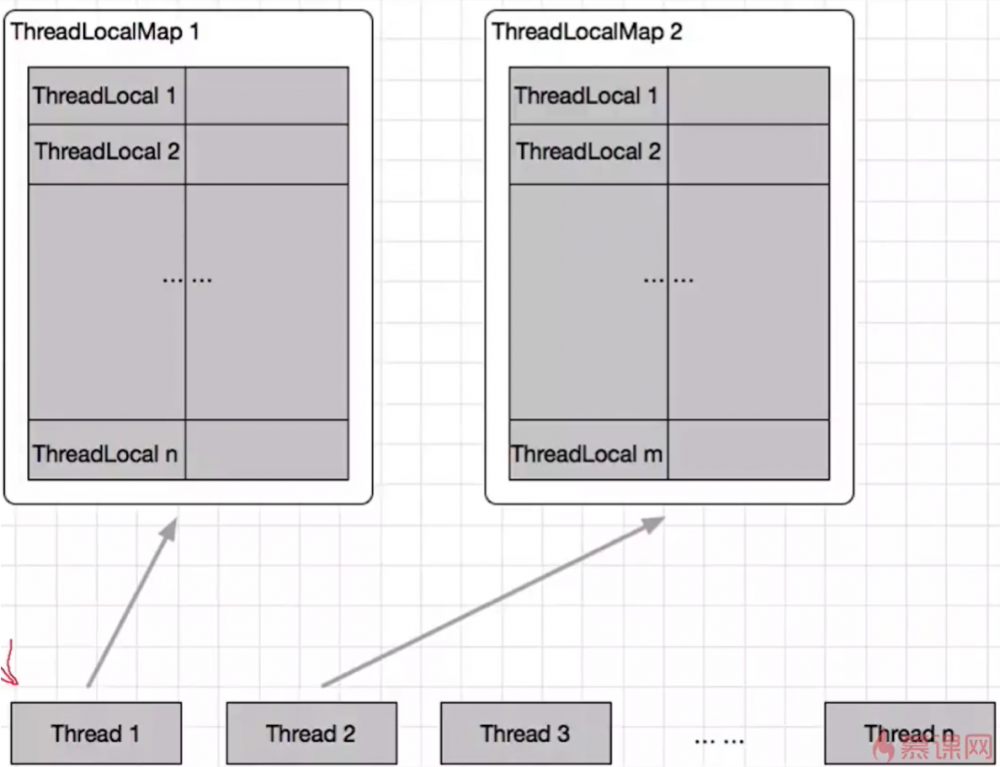
static class ThreadLocalMap {
static class Entry extends WeakReference<ThreadLocal<?>> {
/** The value associated with this ThreadLocal. */
Object value;
Entry(ThreadLocal<?> k, Object v) {
//调用父类,父类是一个弱引用
super(k);
//强引用
value = v;
}
}
复制代码
强引用:当内存不足时触发GC,宁愿抛出OOM也不会回收强引用的内存
弱引用:触发GC后便会回收弱引用的内存
-
正常情况
当Thread运行结束后,ThreadLocal中的value会被回收,因为没有任何强引用了
-
非正常情况
当Thread一直在运行始终不结束,强引用就不会被回收,存在以下调用链
Thread-->ThreadLocalMap-->Entry(key为null)-->value
因为调用链中的 value 和 Thread 存在强引用,所以 value无法被回收 ,就有可能出现 OOM 。
JDK的设计已经考虑到了这个问题,所以在 set() 、 remove() 、 resize() 方法中会扫描到 key 为 null 的 Entry ,并且把对应的 value 设置为 null ,这样 value 对象就可以被回收。
private void resize() {
Entry[] oldTab = table;
int oldLen = oldTab.length;
int newLen = oldLen * 2;
Entry[] newTab = new Entry[newLen];
int count = 0;
for (int j = 0; j < oldLen; ++j) {
Entry e = oldTab[j];
if (e != null) {
ThreadLocal<?> k = e.get();
//当ThreadLocal为空时,将ThreadLocal对应的value也设置为null
if (k == null) {
e.value = null; // Help the GC
} else {
int h = k.threadLocalHashCode & (newLen - 1);
while (newTab[h] != null)
h = nextIndex(h, newLen);
newTab[h] = e;
count++;
}
}
}
setThreshold(newLen);
size = count;
table = newTab;
}
复制代码
但是只有在调用 set() 、 remove() 、 resize() 这些方法时才会进行这些操作,如果没有调用这些方法并且线程不停止,那么调用链就会一直存在,所以可能会发生内存泄漏。
6.2 如何避免内存泄漏(阿里规约)
- 调用
remove()方法,就会删除对应的Entry对象,可以避免内存泄漏,所以 使用完ThreadLocal后,要调用remove()方法。
class Service1 {
public void process() {
User user = new User("鲁毅");
//将User对象存储到 holder 中
UserContextHolder.holder.set(user);
new Service2().process();
}
}
class Service2 {
public void process() {
User user = UserContextHolder.holder.get();
System.out.println("Service2拿到用户名: " + user.name);
new Service3().process();
}
}
class Service3 {
public void process() {
User user = UserContextHolder.holder.get();
System.out.println("Service3拿到用户名: " + user.name);
//手动释放内存,从而避免内存泄漏
UserContextHolder.holder.remove();
}
}
复制代码
6.3 ThreadLocal的空指针异常问题
/**
* ThreadLocal的空指针异常问题
*/
public class ThreadLocalNPE {
ThreadLocal<Long> longThreadLocal = new ThreadLocal<>();
public void set() {
longThreadLocal.set(Thread.currentThread().getId());
}
public Long get() {
return longThreadLocal.get();
}
public static void main(String[] args) {
ThreadLocalNPE threadLocalNPE = new ThreadLocalNPE();
//如果get方法返回值为基本类型,则会报空指针异常,如果是包装类型就不会出错
System.out.println(threadLocalNPE.get());
Thread thread1 = new Thread(new Runnable() {
@Override
public void run() {
threadLocalNPE.set();
System.out.println(threadLocalNPE.get());
}
});
thread1.start();
}
}
复制代码
6.4 空指针异常问题的解决
如果get方法返回值为基本类型,则会报空指针异常,如果是包装类型就不会出错。这是因为基本类型和包装类型存在装箱和拆箱的关系,造成空指针问题的原因在于使用者。
6.5 共享对象问题
如果在每个线程中ThreadLocal.set()进去的东西本来就是多个线程共享的同一对象,比如 static 对象,那么多个线程调用 ThreadLocal.get() 获取的内容还是同一个对象,还是会发生线程安全问题。
6.6 可以不使用ThreadLocal就不要强行使用
如果在任务数很少的时候,在局部方法中创建对象就可以解决问题,这样就不需要使用 ThreadLocal 。
6.7 优先使用框架的支持,而不是自己创造
例如在Spring框架中,如果可以使用 RequestContextHolder ,那么就不需要自己维护 ThreadLocal ,因为自己可能会忘记调用 remove() 方法等,造成内存泄漏。











![[HBLOG]公众号](https://www.liuhaihua.cn/img/qrcode_gzh.jpg)

